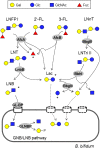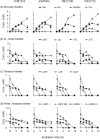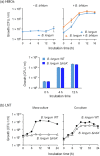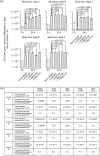Sharing of human milk oligosaccharides degradants within bifidobacterial communities in faecal cultures supplemented with Bifidobacterium bifidum
- PMID: 30228375
- PMCID: PMC6143587
- DOI: 10.1038/s41598-018-32080-3
Sharing of human milk oligosaccharides degradants within bifidobacterial communities in faecal cultures supplemented with Bifidobacterium bifidum
Abstract
Gut microbiota of breast-fed infants are generally rich in bifidobacteria. Recent studies show that infant gut-associated bifidobacteria can assimilate human milk oligosaccharides (HMOs) specifically among the gut microbes. Nonetheless, little is known about how bifidobacterial-rich communities are shaped in the gut. Interestingly, HMOs assimilation ability is not related to the dominance of each species. Bifidobacterium longum susbp. longum and Bifidobacterium breve are commonly found as the dominant species in infant stools; however, they show limited HMOs assimilation ability in vitro. In contrast, avid in vitro HMOs consumers, Bifidobacterium bifidum and Bifidobacterium longum subsp. infantis, are less abundant in infant stools. In this study, we observed altruistic behaviour by B. bifidum when incubated in HMOs-containing faecal cultures. Four B. bifidum strains, all of which contained complete sets of HMO-degrading genes, commonly left HMOs degradants unconsumed during in vitro growth. These strains stimulated the growth of other Bifidobacterium species when added to faecal cultures supplemented with HMOs, thereby increasing the prevalence of bifidobacteria in faecal communities. Enhanced HMOs consumption by B. bifidum-supplemented cultures was also observed. We also determined the complete genome sequences of B. bifidum strains JCM7004 and TMC3115. Our results suggest B. bifidum-mediated cross-feeding of HMOs degradants within bifidobacterial communities.
Conflict of interest statement
The authors declare no competing interests.
Figures





Similar articles
-
Physiology of consumption of human milk oligosaccharides by infant gut-associated bifidobacteria.J Biol Chem. 2011 Oct 7;286(40):34583-92. doi: 10.1074/jbc.M111.248138. Epub 2011 Aug 9. J Biol Chem. 2011. PMID: 21832085 Free PMC article.
-
Galacto- and Fructo-oligosaccharides Utilized for Growth by Cocultures of Bifidobacterial Species Characteristic of the Infant Gut.Appl Environ Microbiol. 2020 May 19;86(11):e00214-20. doi: 10.1128/AEM.00214-20. Print 2020 May 19. Appl Environ Microbiol. 2020. PMID: 32220841 Free PMC article.
-
Human milk oligosaccharide metabolism and antibiotic resistance in early gut colonizers: insights from bifidobacteria and lactobacilli in the maternal-infant microbiome.Gut Microbes. 2025 Dec;17(1):2501192. doi: 10.1080/19490976.2025.2501192. Epub 2025 May 9. Gut Microbes. 2025. PMID: 40340669 Free PMC article.
-
Varied Pathways of Infant Gut-Associated Bifidobacterium to Assimilate Human Milk Oligosaccharides: Prevalence of the Gene Set and Its Correlation with Bifidobacteria-Rich Microbiota Formation.Nutrients. 2019 Dec 26;12(1):71. doi: 10.3390/nu12010071. Nutrients. 2019. PMID: 31888048 Free PMC article. Review.
-
Effects of Human Milk Oligosaccharides in Infant Health Based on Gut Microbiota Alteration.J Agric Food Chem. 2023 Jan 18;71(2):994-1001. doi: 10.1021/acs.jafc.2c05734. Epub 2023 Jan 5. J Agric Food Chem. 2023. PMID: 36602115 Review.
Cited by
-
Strain-specific strategies of 2'-fucosyllactose, 3-fucosyllactose, and difucosyllactose assimilation by Bifidobacterium longum subsp. infantis Bi-26 and ATCC 15697.Sci Rep. 2020 Sep 28;10(1):15919. doi: 10.1038/s41598-020-72792-z. Sci Rep. 2020. PMID: 32985563 Free PMC article.
-
Bifidobacteria: insights into the biology of a key microbial group of early life gut microbiota.Microbiome Res Rep. 2021 Nov 19;1(1):2. doi: 10.20517/mrr.2021.02. eCollection 2021. Microbiome Res Rep. 2021. PMID: 38045555 Free PMC article. Review.
-
Milk glycan metabolism by intestinal bifidobacteria: insights from comparative genomics.Crit Rev Biochem Mol Biol. 2022 Oct-Dec;57(5-6):562-584. doi: 10.1080/10409238.2023.2182272. Epub 2023 Mar 3. Crit Rev Biochem Mol Biol. 2022. PMID: 36866565 Free PMC article. Review.
-
Two Novel α-l-Arabinofuranosidases from Bifidobacterium longum subsp. longum Belonging to Glycoside Hydrolase Family 43 Cooperatively Degrade Arabinan.Appl Environ Microbiol. 2019 Mar 6;85(6):e02582-18. doi: 10.1128/AEM.02582-18. Print 2019 Mar 15. Appl Environ Microbiol. 2019. PMID: 30635377 Free PMC article.
-
Growth and Gastrointestinal Tolerance in Healthy Term Infants Fed Milk-Based Infant Formula Supplemented with Five Human Milk Oligosaccharides (HMOs): A Randomized Multicenter Trial.Nutrients. 2022 Jun 24;14(13):2625. doi: 10.3390/nu14132625. Nutrients. 2022. PMID: 35807803 Free PMC article. Clinical Trial.
References
Publication types
MeSH terms
Substances
LinkOut - more resources
Full Text Sources
Other Literature Sources
Medical
Molecular Biology Databases
Research Materials

